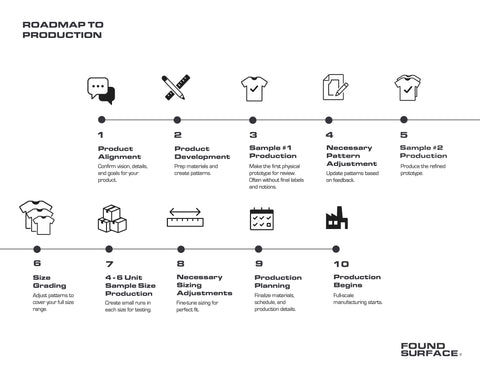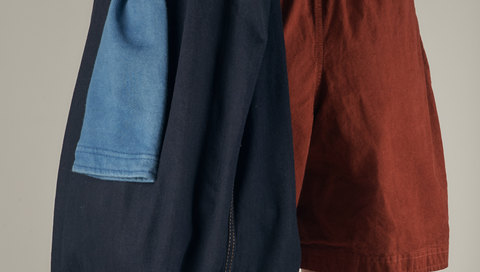For many brands, apparel development feels less like a straight path and more like a maze. One vendor handles patterns, another manages sewing, someone else deals with grading — and somehow, the brand is left piecing it all together. The result? A process full of jargon, detours, and costly mistakes.
At Found Surface, we’ve built a different approach. We break down the journey into a structured, transparent roadmap. Each stage has a purpose. Each step builds on the last. And most importantly, brands always know what comes next.
This blog walks through the ten key stages of apparel development, from first vision to full-scale production — not just what happens, but why it matters.
1. Product Alignment
Every successful garment begins with alignment. Before fabric is cut or a sample is sewn, we pause to confirm intent. Who is this product for? How will it live within your collection? What does success look like?
Skipping alignment is like building a house without a floor plan. The result may stand — but it will feel unstable. A well-aligned product brief, by contrast, turns a vague idea into a direction that saves months later in revisions, delays, and missteps.
2. Product Development
Once alignment is clear, development begins. This is the groundwork: creating patterns, assembling tech packs, and preparing material details. If alignment is the “why,” development is the “how.”
Think of it as architectural plans. The clearer the drawings, the smoother the build. At this stage, details like seam finishes, fabric weights, and fit intent aren’t just nice to have — they are what turn creative ideas into instructions a factory can follow.
3. Sample #1: First Prototype
With development in place, the first prototype is created. For many designers, this is the moment of truth: the concept becomes something you can touch, try on, and react to.
Here’s the key — perfection is not the goal. The first sample is a test. It shows how materials, construction, and design decisions interact in real life. It provides a canvas for feedback. Brands that expect perfection at this stage often get stuck in endless rounds. Those who treat it as a learning step move faster.
4. Pattern Adjustment
Every sample tells a story. Maybe the shoulder seam needs refining. Maybe the neckline feels off. Maybe the fabric performs differently than expected.
Rather than viewing these adjustments as setbacks, see them as progress. Each refinement makes the next sample stronger. Small changes — a millimeter here, a fabric shift there — compound into garments that look and feel exactly as intended.
5. Sample #2: Refined Prototype
With refinements in place, a second prototype is built. This is where the garment starts to feel real. The proportions align, the construction feels polished, and the design intent comes through clearly.
This stage is about moving from concept to confidence. By the end of it, most brands can see their garment as it will exist in the market — not just as an idea, but as a tangible product.
6. Size Grading
Once the design is approved, it’s time to scale. Patterns are graded across the full size range, ensuring consistency from the smallest to the largest size.
Many factories treat grading as an afterthought, relying on shortcuts that distort proportions. The result is the all-too-familiar issue: one size fits beautifully, another feels wrong. But grading done well is design in itself — a way of preserving intent for every body.
7. Small-Run Testing
Before committing to large-scale production, a small run is produced: usually 4–6 units per size. This phase is often skipped, but it’s one of the most important.
Testing reveals what the lab or prototype can’t: how garments behave in real-world conditions. Fabrics shrink differently after washing. Seams behave differently after wear. Fit issues only emerge when multiple sizes are tested. Small runs provide answers early — before mistakes are multiplied.
8. Sizing Adjustments
Feedback from the test run informs final refinements. Adjusting a waistline by half an inch, lengthening a sleeve, balancing proportions — these small changes protect the integrity of the collection.
This step is about quality at scale. Without it, issues slip through and replicate across hundreds of units. With it, brands launch with garments that feel consistent, considered, and trustworthy.
9. Production Planning
Only after design and sizing are locked do we move into planning. This stage is about logistics: materials are confirmed, timelines mapped, and checkpoints established.
Too often, brands dive into production with vague dates and incomplete sourcing. The result is last-minute substitutions, blown budgets, and endless waiting. Planning eliminates the guesswork. When everything is structured before the first stitch is sewn, production flows smoothly.
10. Production
Finally, full-scale manufacturing begins. But even here, clarity matters. In traditional factories, ownership of patterns and files is withheld, creating dependency. Communication disappears the moment production starts.
We take a different approach: brands retain ownership of their work, and transparency continues all the way through delivery. Production becomes the natural conclusion of a structured process, not another black box to worry about.
Why a Roadmap Matters
The apparel process doesn’t have to feel unpredictable. When broken into clear stages, it becomes collaborative, efficient, and even enjoyable.
-
Alignment ensures everyone is moving in the same direction.
-
Development translates vision into technical clarity.
-
Sampling and adjustments allow creativity to meet reality.
-
Grading and testing protect quality across sizes.
-
Planning eliminates surprises.
-
Production delivers results with confidence.
Each step builds momentum. Each decision compounds. The roadmap isn’t just about making garments — it’s about giving brands the clarity they need to grow.









